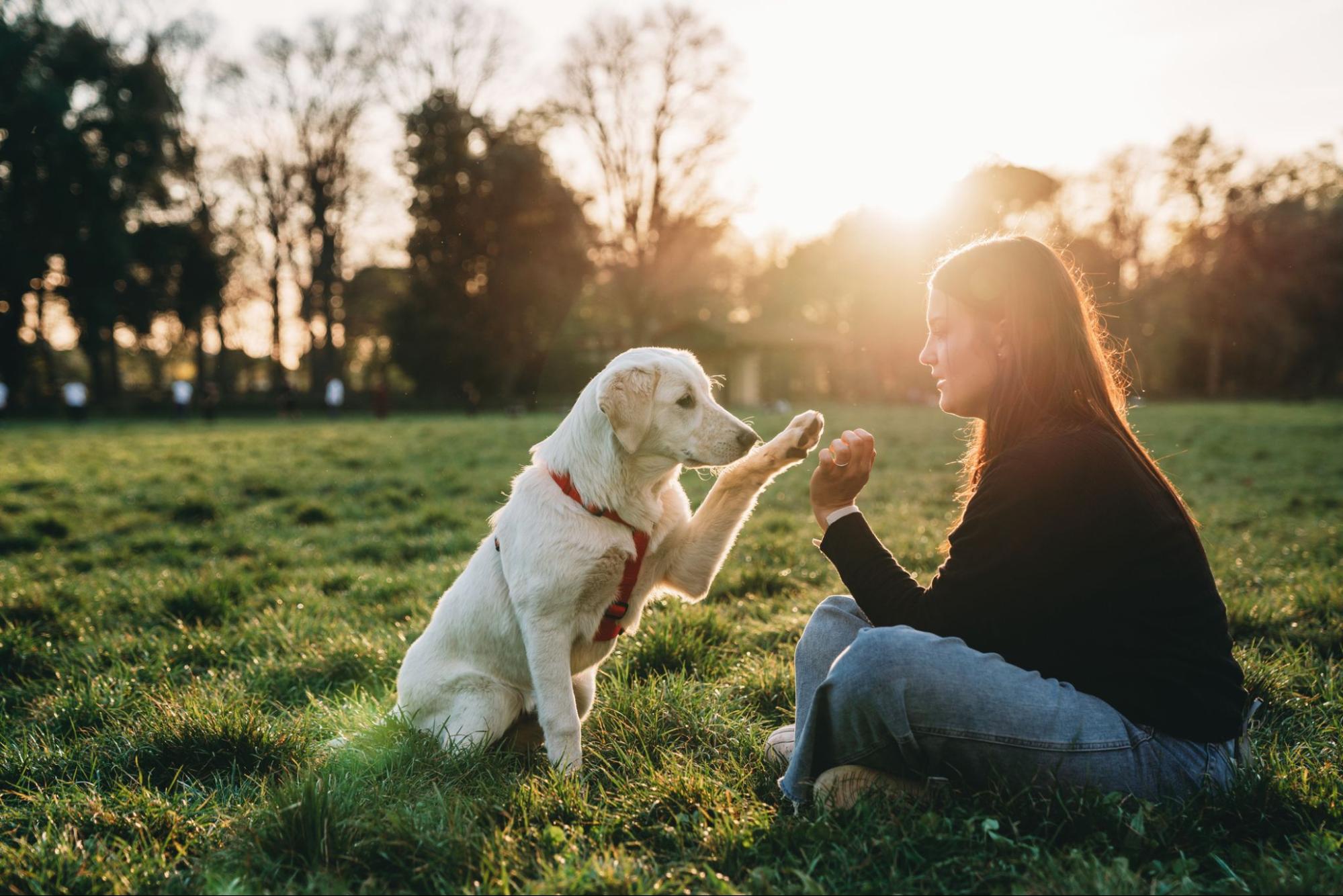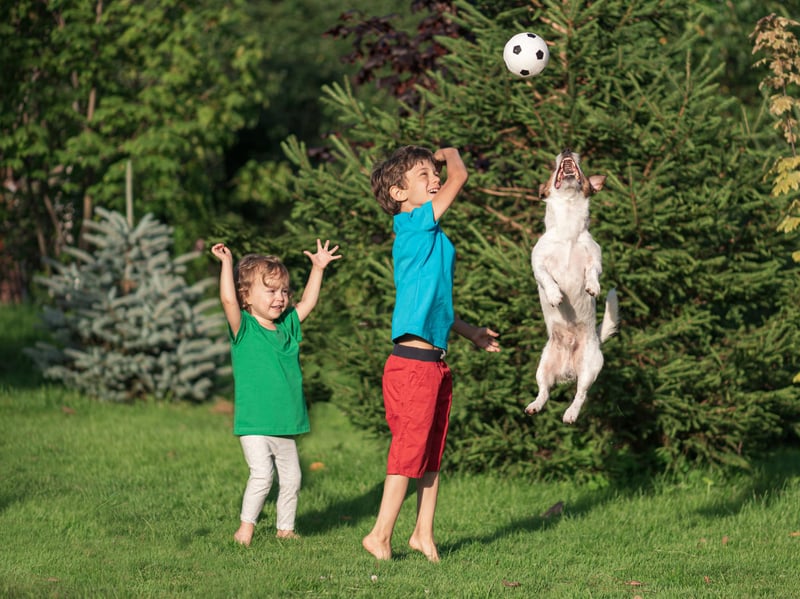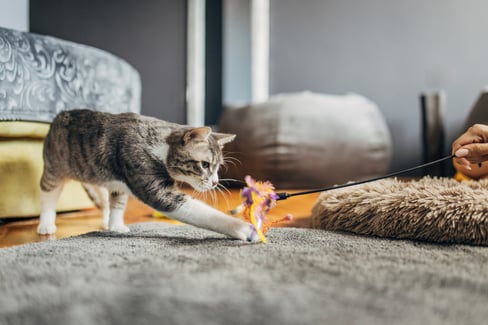Table of Contents
As dog owners, we’re always hyper-focused on our dog’s physical health. Making sure they have the best food, the best vet care, and additional health supports like joint supplements to keep their bodies strong as they age. While our pups' physical health is important, their mental health is also significant.
Poor mental health in dogs can lead to a wide range of behavioural problems that can significantly affect the trajectory of their lives, from becoming unadoptable due to aggression to eating disorders.
The most common mental health disorders that dogs can suffer from include:
- Anxiety: Usually presents as avoiding eye contact, excessively licking their lips, moving away from people who try to approach them, pacing in circles or back and forth, trembling, whimpering or whining, and excessive yawning.
- Separation Anxiety: Occurs when a dog exhibits signs of anxiety when they are separated from their loved ones, whether that be their owners or other animals. Dogs with separation anxiety may pace back and forth in front of an exit (where the owner or other animals left), whine and act very clingy when the party returns, defecate or urinate in the home when they usually don’t, excessively howl or bark, or engage in destructive chewing behaviour.
- Depression: Can be trickier to diagnose, but usually presents as appetite loss, lethargy, trouble sleeping or sleeping more than usual, and avoiding social interactions.
- Compulsive behaviours: These behaviours are essentially heightened presentations of normal dog behaviours, to the point where they become a problem for the dog and owner. For example, behaviours like barking, chewing, and tail chasing are normal for a dog, but when they engage in these behaviours constantly it can be an indication of a compulsive issue that needs to be addressed. In some cases, compulsive behaviour can be a result of anxiety, fear, or even a health condition like dermatitis.
While dog enrichment toys or activities may not solve all mental health issues with dogs, they are often part of a larger treatment process focused on helping the dog live the best life they possibly can. Regular dog enrichment can reduce stress, help prevent your dog from getting bored, and reduce unwanted behaviours.
In this article, we explore the importance of dog enrichment, including benefits and different activities that you can do with your own pup.
What Is Considered Dog Enrichment?
Although dogs have been domesticated over tens of thousands of years, that doesn’t mean that they’ve lost their natural, innate behaviours. Dogs love chasing, smelling, chewing, scavenging, hunting, and more. It’s one of the reasons working dogs actually do what they are trained to do: they genuinely enjoy it and we’ve bred them to exhibit certain behaviours more than others.
Allowing your dog to engage in these behaviours through dog enrichment activities gives them an outlet for their energy and allows them to do things they enjoy in a safe environment. After all, all dogs, even working dogs, need the opportunity to play!
Types of Dog Enrichment
The first thing you might think of when you hear “dog enrichment” is a toy filled with peanut butter or a thrilling game of tug-o-war with a rope toy. While these are great examples of dog enrichment toys, there are actually five different types of dog enrichment:
1. Social
One of the most important things you can do with a new puppy is socialization. Exposing a dog to new sights, sounds, people, animals, and objects in a safe way is a great way to build up your dog’s confidence and help them learn and grow.
Dogs that are properly socialized have less fear, anxiety, and aggression. The best time to start socializing your puppy is when they are between 3 weeks and 20 weeks of age. This period is when your puppy is the best at learning, as they are often not fearful of new sights, sounds, people, or objects during this time. If a puppy misses out on proper socialization during this time of their life, they have a greater chance of developing fearful behaviours later in life, especially in new situations.
However, that doesn’t mean that if you have an adolescent or adult dog that they can’t be socialized or trained, you just need to be more patient with the process. Expose your dog to new places, people, and other animals, but do so slowly and safely. Depending on your dog’s reactions and overall behaviour, you may have to enlist the help of a professional dog trainer to give you tips on proper socialization. The trainer will analyze your dog’s overall behaviour, body language, and reactions and develop a training plan from there.
2. Nutritional (Dog Enrichment Feeders)
Dogs love to scavenge and forage. Dog enrichment feeders are a great way to make mealtimes fun or add fun to giving treats. There are a wide range of different dog enrichment feeders, including:
- Dog puzzles: Dog enrichment toys that you put a treat into, and your dog must figure out how to get the treat out
- Snuffle mats: Often made out of pieces of fabric, these mats are perfect for hiding kibble or treats so that your dog needs to use their nose to sniff out the food
- Treat scavenger hunt: hiding treats around your home or in a room is a good way to encourage your dog to explore and search for their prize
- Slow dog feeder bowls: These are bowls with various shapes inside that prevent your dog from being able to scarf all their food down all at once, encouraging them to slow down when they eat, aiding in proper digestion while at the same time stimulating their mind
3. Occupational
Occupational dog enrichment is especially beneficial for dogs bred for working purposes, like herding dogs. These activities involve giving the dog a job, which helps them focus their mind on a task and burn excess energy. It also helps them utilize problem-solving skills and cognitive thinking abilities to complete the task before them.
Some examples of occupational dog enrichment activities include:
- Dog sports (e.g., agility, GRC dog sports, fly balls, dock diving, protection, detection, and tracking)
- Obedience training
- Herding
- Therapy, emotional support, or service dog training
- Sniffer dog training (e.g., being trained to sniff out drugs or organic substances at airports)
4. Sensory
By stimulating your dog’s basic senses—sight, sound, smell, and touch—you can provide your dog with enrichment that can be very beneficial, especially for dogs that are prone to stress or anxiety. One study that analyzed 15 dogs at a shelter in England found that using scented cloths, specifically with vanilla, coconut, ginger, and valerian (a type of flower), helped to calm the dogs by reducing vocalizations (barking and whining) and helping them sleep. By incorporating these scents in your dog’s enrichment activities, you might just notice these benefits in your pup for yourself!
Some dog enrichment ideas that focus on sensory perception include:
- Taking your dog for a walk in a different area exposes them to new sights, sounds, and smells
- People watching at a park
- Spraying calming scents on their bed or blanket
5. Physical
Playtime is the best time for your pup! A thrilling game of tug-o-war or ball are both great ways to play with your pup and help them burn excess energy while spending time with you. You can also take your dog with you while you explore the outdoors, like hiking, kayaking, swimming, and fishing. These activities help keep your pup mentally stimulated, but they also help keep them physically fit and healthy.
Another important way that you can support your dog’s ability to engage in physical activity is by giving them a daily joint supplement. As many as 20% of dogs will experience joint degradation in their lifetime, increasing depending on breed and genetics. TRI-ACTA is a great choice as a preventative supplement, as it contains a variety of natural ingredients that support your dog’s overall joint health:
|
TRI-ACTA Ingredient |
Benefit |
|
Contains two types of glucosamine for dogs: Glucosamine Sulfate and HCl |
Using these two types of glucosamine in one supplement gives your dog maximum support for their joint health:
|
|
Chondroitin |
|
|
Methylsulfonylmethane (MSM) |
|
|
Hyaluronic Acid |
|
TRI-ACTA H.A. for Pets
Our maximum strength formula is optimally designed to accelerate the formation of cartilage, minimize inflammation, expedite the healing process, and improve joint conditions.

Benefits of Dog Enrichment Toys
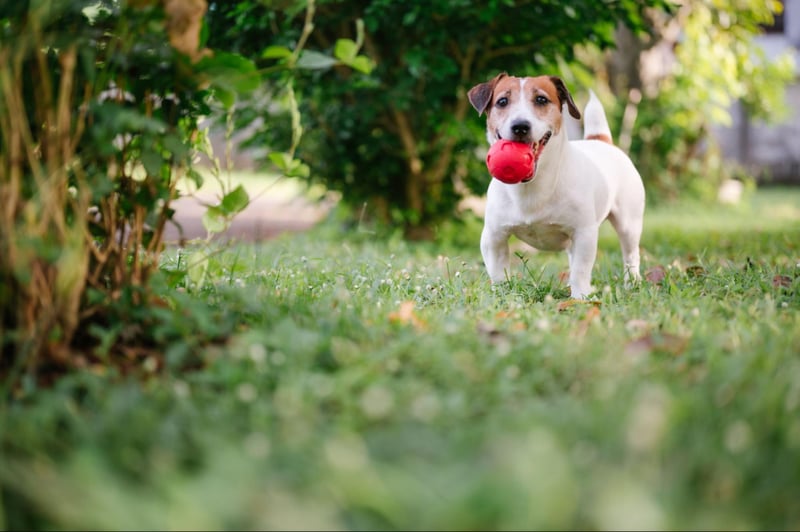
Providing mental stimulation and exercise for your dog has many benefits for their overall mental health. Just like people, dogs can get bored, so they need opportunities to play and otherwise work their minds to prevent them from engaging in destructive and unwanted behaviours and keep them healthy and happy.
1. Reduces Stress
Dogs that are stressed and anxious can not only start engaging in destructive behaviours like chewing, biting, or digging, but they can also develop certain conditions over time as a result of continued stress. These conditions are outlined in the table below:
|
Medical Conditions Initiated or Exacerbated by Stress in Dogs |
Description |
|
Cardiovascular Issues |
Consistent stress can lead to the buildup of cortisol, a hormone that elevates blood pressure in the body and puts additional stress on the heart. It also affects the adrenal glands (kidneys), potentially causing or increasing the risk of diseases like Cushing’s Syndrome. |
|
Eating Disorders |
Dogs can react to stress by overeating or undereating, which can negatively affect their overall health. Overeating can lead to weight gain in dogs, which can affect joint health |
|
Gastrointestinal Issues |
Increased stress can result in increased gastrointestinal issues, such as vomiting and diarrhea. |
|
Suppressed Immune System |
Another effect of increased cortisol in your dog’s system is immune system suppression. When your dog has a suppressed immune system, they are more susceptible to illness and disease. |
|
Slowed Healing |
Stress can increase healing time in dogs, meaning it will take longer for them to recover from an injury or illness if they are under chronic stress. |
2. Boosts Cognitive Performance
Just like people, their cognitive abilities can increase when dogs can work their brains every day with various dog enrichment activities and toys. As dogs age, their social behaviour and overall adaptability can suffer, possibly leading to a disorder called Canine Cognitive Dysfunction (CCDS). Thankfully, we can train our dog’s brains to reduce the effects of aging on the brain through dog enrichment.
Simple enrichment activities like catching balls, obedience training, swimming, and puppy playgroups are just a few examples of dog enrichment ideas that you can incorporate into your pup’s playtime.
3. Improves your Dog’s Confidence
Dog enrichment games and activities can improve your dog’s confidence. Exposing them to new sights, sounds, and smells regularly gets them used to the idea that they will likely experience something new, reducing their anxiety surrounding it over time.
4. Strengthens Your Bond
Dog enrichment also helps you strengthen your bond with your pup through playtime and simply spending time together. It also increases their trust in you because they get to know your mannerisms and body language just as much as you do theirs.
Dog Enrichment Activities
Giving your dog enrichment should be a fun experience for you and your pup. There are endless dog enrichment ideas that you can use to play with your pup or simply stimulate their mind. Here are some ideas that you can use in different situations:
Dog Enrichment Ideas at Home
When you’re stuck at home with your pup, you might struggle with finding a way to keep them entertained besides throwing them a toy. But there are ways that you can provide your dog with the mental stimulation they crave, even if you don’t have a lot of space.
- Use snuffle mats to hide treats or kibble, and let your dog sniff them out. If you don’t have a snuffle mat on hand, folding towels or blankets to hide treats is an effective alternative. Your dog will enjoy using their excellent sense of smell to sniff out their favourite treat.
- Rotate their toys. Dogs can get bored of the same old toys that they play with all the time. Putting some of their toys away and taking them out later when they’ve likely forgotten about them is a great way to rekindle interest in older toys without constantly purchasing new ones.
- Give them puzzles. Puzzle toys are a great way to enrich your dog, but it doesn’t mean you have to buy a new puzzle toy every time. Using household items like old margarine containers (that are cleaned) or even cardboard boxes to make DIY dog enrichment toys is a great idea. Plus, it’s not a big deal if your dog destroys the toy! Just make sure they don’t ingest any of the materials.
- Give them something to watch. Dogs love to watch what’s going on outside. Giving your dog a way to look out the window to people watching, or putting a bird feeder outside in your yard to attract birds, is a great way to entertain your dog.
- DIY agility course: If you have a backyard or access to a larger room, a DIY agility course is a great way to help your pup exercise and work their mind at the same time. Using a combination of boxes, homemade ramps, pet tunnels, and more, you can create an agility course to lead your pup through. To get them interested, tempt them through the course using treats.
- Frozen treats: If it’s hot outside, giving your dog a frozen treat is a great way to keep them occupied while helping them beat the heat. Because the treat is frozen, eating it will take them a while, giving them a tasty challenge.
Dog Enrichment Games to Help Your Dog
Enriching games can significantly benefit your furry friend's mental and physical well-being. Here are some engaging games to stimulate your dog:
- Scent work: Place treats inside scent boxes or containers (e.g., Tupperware with holes). Let your dog use their nose to find the box with the treat. Increase difficulty by adding more boxes or using stronger scents.
- Name that toy: Teach your dog the names of their toys. Ask them to bring a specific toy by name, gradually increasing the difficulty as they learn more names.
- Bubble chase: Some dogs love chasing bubbles. Use pet-friendly bubbles for a playful and active session.
- New trick training: Teach your dog a new trick or reinforce existing commands. Mental stimulation through learning keeps their brain engaged.
How to Incorporate Enrichment Dog Toys in Training
Using dog enrichment toys can be a great way to complement and enhance your dog’s training. Here are some ways that you can incorporate them into your training:
- Use toys as rewards: Instead of traditional treats, reward your dog with playtime using their favorite toy. This reinforces good behavior while integrating fun and training. You may have observed police sniffer dogs or border security dogs being rewarded with a toy after a job well done. Using a toy over a treat maintains the dog’s focus and helps satiate their natural instinct to play and interact.
- Use toys to transition to training: Allow your dog a brief play session with an enrichment toy before engaging in training. This helps release excess energy and can focus their attention on the subsequent training session.
- Interactive toy training: Use interactive toys that require your dog to perform certain actions, such as pressing buttons or pulling levers, to access treats or toys. You can tie commands or behaviors to these actions, reinforcing training.
- Play breaks during training: Break up training sessions with short play breaks using enrichment toys. This prevents training from becoming monotonous and keeps your dog motivated.
Dog Enrichment Recipes to Try
Homemade treats can be a delightful addition to your dog's enrichment routine. Here are some recipes for different types of healthy dog treats that you can try:
Frozen Fruit Pops
A frozen fruit pop is a great option if it’s hot outside or you just want to give your dog a delicious cold treat. While dogs can technically eat human popsicles, they can contain an artificial sweetener called xylitol, which has been shown to be toxic to dogs. The best action is to use natural ingredients like real fruit instead of reaching for anything with artificial sweeteners.
- Ingredients: Unsweetened applesauce, mashed ripe bananas, blueberries, strawberries (chopped)
- Directions: Mix the ingredients, pour into ice cube trays or silicone molds, and freeze. These fruity popsicles are a refreshing treat for your dog on hot days.
Peanut Butter and Banana Frozen Treats
- Ingredients: Peanut butter (xylitol-free), mashed ripe bananas, plain yogurt
- Directions: Mix peanut butter, mashed bananas, and yogurt. Pour the mixture into ice cube trays or silicone molds, then freeze. This frozen treat is both tasty and soothing for your dog's gums.
Pumpkin & Greek Yogurt Treats
- Ingredients: Canned pumpkin puree, plain Greek yogurt
- Directions: Mix equal parts pumpkin puree and Greek yogurt. Pour into ice cube trays or silicone molds and freeze. This combination is not only tasty but also provides digestive benefits for dogs
HOT TIP: Using a fun recipe like one of the ones listed above is a great way to entice your dog to gobble up their daily supplement as well! Because TRI-ACTA is a powdered supplement, it’s easy to add to any of the recipes above. And because it’s flavourless, your dog won’t even know about the addition.
Summary
The mental well-being of our dogs is as crucial as their physical health. Behavioral issues stemming from poor mental health can significantly impact a dog's life trajectory, from adoption difficulties to the development of eating disorders or aggression. Understanding common mental health disorders in dogs—such as anxiety, separation anxiety, depression, and compulsive behaviors—is key to supporting our pets effectively.
Dog enrichment plays a pivotal role in maintaining a dog's mental health. It encompasses various activities tailored to their natural instincts and behaviors, enabling them to engage in activities they enjoy in a safe environment.
Another important way to support your dog’s overall health is by giving them a daily joint supplement. TRI-ACTA is a great option as it contains 100% active and natural ingredients and is easy to incorporate into your dog’s daily diet by simply sprinkling the powder on top of their existing food. TRI-ACTA contains no fillers, additives, or preservatives, so you don’t have to worry about adverse reactions in your dog.
Purchase TRI-ACTA online or learn where to buy at a store near you.
TRI-ACTA for Pets
A proactive approach for developing and younger adult pets to maintain optimal joint health mobility, minimize inflammation and fend off age-related ailments.
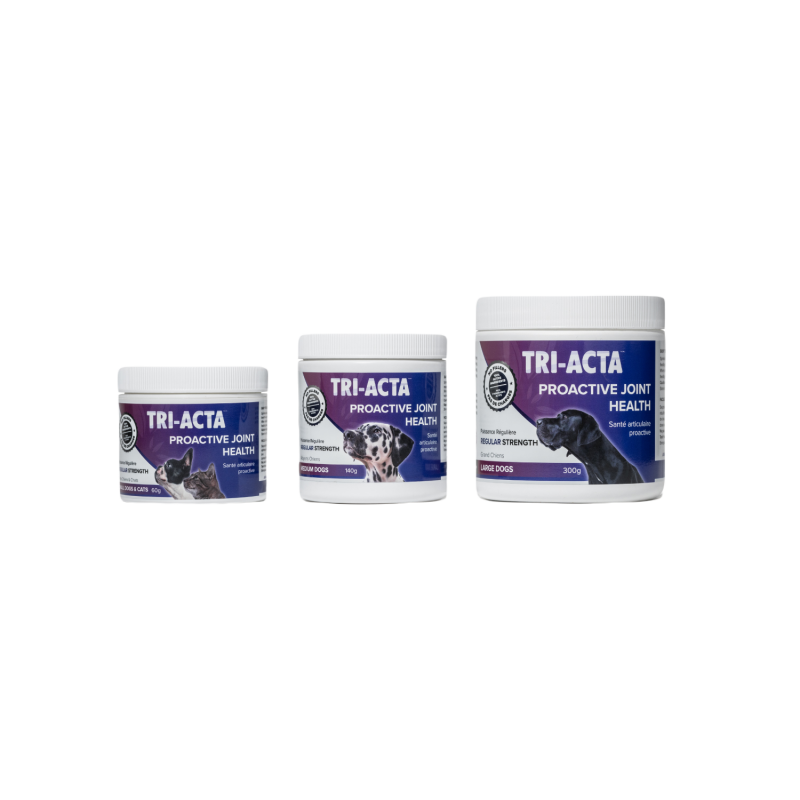
Newsletter Signup
Subscribe to our newsletter to receive the latest news and exclusive offers.
.jpg?height=2000&name=Cliick_Integricare-DISPLAY-REVISEDV2%20(1).jpg)
Proactive & Therapeutic Joint Supplements
When given daily, Integricare joint supplements recover bone and joint injuries faster and help prevent mobility injuries from happening in the first place.

